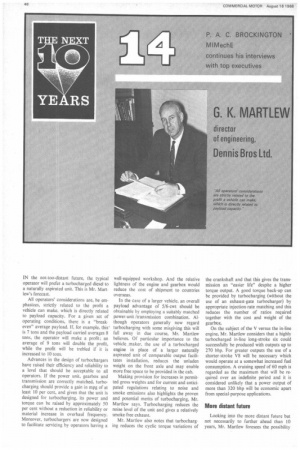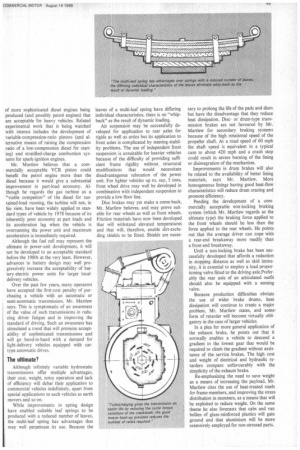G. K. MARTLEW
Page 50

Page 51

If you've noticed an error in this article please click here to report it so we can fix it.
director of engineering,
Dennis Bros Ltd.
'All operators considerations are stnctly related to the profit a vehicle can make, which is directly related to payload capacity "
IN the not-too-distant future, the typical operator will prefer a turbocharged diesel to a naturally aspirated unit. This is Mr. Mart lew's forecast.
All operators' considerations are, he emphasizes, strictly related to the profit a vehicle can make. which is directly related to payload capacity. For a given set of operating conditions, there is a "breakeven" average payload. If, for example, this is 7 tons and the payload carried averages 8 tons, the operator will make a profit: an average of 9 tons will double the profit, while the profit will be trebled if it is increased to 10 tons.
Advances in the design of turbochargers have raised their efficiency and reliability to a level that should be acceptable to all operators. If the power unit, gearbox and transmission are correctly matched, turbocharging should provide a gain in mpg of at least 10 per cent, and given that the unit is designed for turbocharging, its power and torque can be raised by approximately 50 per cent without a reduction in reliability or material increase in overhaul frequency. Moreover, turbochargers are now designed to facilitate servicing by operators having a well-equipped workshop. And the relative lightness of the engine and gearbox would reduce the cost of shipment to countries overseas.
In the case of a larger vehicle, an overall payload advantage of 5/6-cwt should be obtainable by employing a suitably matched power-unit /transmission combination. Although operators generally now regard turbocharging with some misgiving this will fall away in due course, Mr. Martlew believes. Of particular importance to the vehicle .maker, the use of a turbocharged engine in place of a larger naturally aspirated unit of comparable output facilitates installation, reduces the unladen weight on the front axle and may enable more free space to be provided in the cab.
Making provision for increases in permitted gross weights and for current and anticipated regulations relating to noise and smoke emissions also highlights the proven and potential merits of turbocharging, Mr. Martlew says. Turbocharging reduces the noise level of the unit and gives a relatively smoke-free exhaust.
Mr. Martlew also notes that turbocharging reduces the cyclic torque variations of the crankshaft and that this gives the transmission an "easier life" despite a higher torque output. A good torque back-up can be provided by turbocharging (without the use of an exhaust-gate turbocharger) by appropriate injection-rate matching and this reduces the number of ratios required together with the cost and weight of the gearbox.
On the subject of the V versus the in-line engine, Mr. Martlew considers that a highly turbocharged in-line long-stroke six could successfully be produced with outputs up to 270 bhp. For greater outputs the use of a shorter-stroke V8 will be necessary which would operate at a somewhat increased fuel consumption. A cruising speed of 60 mph is regarded as the maximum that will be required over an indefinite period and it is considered unlikely that a power output of more than 320 bhp will be economic apart from special-purpose applications.
More distant future Looking into the more distant future but not necessarily to further ahead than 10 years, Mr. Martlew foresees the possibility of more sophisticated diesel engines being produced (and possibly petrol engines) that are acceptable for heavy vehicles. Related experimental work that is being watched with interest includes the development of variable-compression-ratio pistons (and alternative means of raising the compression ratio of a low-compression diesel for starting) and stratified-charge combustion systems for spark-ignition engines.
Mr. Martlew believes that a commercially acceptable VCR piston could benefit the petrol engine more than the diesel because it would give a substantial improvement in part-load economy. Although he regards the gas turbine as a "viable competitor" of the diesel for sustained-load running, the turbine will not, in his view, have been widely applied to standard types of vehicle by 1978 because of its inherently poor economy at part loads and its acceleration lag when the vehicle is overrunning the power unit and maximum acceleration is immediately required.
Although the fuel cell may represent the ultimate in power-unit development, it will not be developed to an acceptable standard before the 1980s at the very least. However, advances in battery design may well progressively increase the acceptability of battery-electric power units for larger localdelivery vehicles.
Over the past few years, many operators have accepted the first-cost penalty of purchasing a vehicle with an automatic or semi-automatic transmission, Mr. Martlew says. This is symptomatic of an awareness of the value of such transmissions in reducing driver fatigue and in improving the standard of driving. Such an awareness has stimulated a trend that will promote acceptability of sophisticated transmissions and will go hand-in-hand with a demand for light-delivery vehicles equipped with cartype automatic drives.
The ultimate?
Although infinitely variable hydrostatic transmissions offer multiple advantages, their cost, weight, noisy operation and lack of efficiency will debar their application to commercial vehicles indefinitely, apart from special applications to such vehicles as earth movers and so on.
While improvements in spring design have enabled suitable leaf springs to be produced with a reduced number of leaves, the multi-leaf spring has advantages that may well perpetuate its use. Because the leaves of a multi-leaf spring have differing individual characteristics, there is no "whipback" as the result of dynamic loading.
Air suspension may be successfully developed for application to rear axles for rigids as well as artics but its application to front axles is complicated by steering-stability problems. The use of independent front suspension is unsuitable for heavier vehicles because of the difficulty of providing sufficient frame rigidity without, structural modifications that would necessitate disadvantageous relocation of the power unit. For lighter vehicles up to, say, 5 tons, front wheel drive may well be developed in combination with independent suspension to provide a low floor line.
Disc brakes may yet make a come-back, Mr. Martlew believes, and may prove suitable for rear wheels as well as front wheels. Friction materials have now been developed that will withstand elevated temperatures and that will, therefore, enable dirt-excluding shields to bc fitted. Shields are neces sary to prolong the life of the pads and discs but have the disadvantage that they reduce heat dissipation. Discor drum-type transmission brakes are not favoured by Mr. Martlew for secondary braking systems because of the high rotational speed of the propeller shaft. At a road speed of 60 mph the shaft speed is equivalent in a typical case to about 420 mph and a crash stop could result in severe burning of the lining or disintegration of the mechanism.
Improvements in drum brakes will also be related to the availability of better lining materials, says Mr_ Martlew. More homogeneous linings having good heat-flow characteristics will reduce drum crazing and promote efficiency.
Pending the development of a commercially acceptable non-locking braking system (which Mr. Martlew regards as the ultimate type) the braking force applied to the front wheels should be less than the force applied to the rear wheels. He points out that the average driver can cope with a rear-end breakaway more readily than a front-end breakaway.
Until a non-locking brake has been successfully developed that affords a reduction in stopping distance as well as skid immunity, it is essential to employ a load proportioning valve fitted to the driving axle.Preferably the rear axle of an articulated outfit should also be equipped with a sensing valve.
Because production difficulties obviate the use of wider brake drums, heat dissipation will continue to create a major problem, Mr. Martiew states, and some form of retarder will become virtually obligatory in the case of larger vehicles.
In a plea for more general application of the exhaust brake, he points out that it normally enables a vehicle to descend a gradient in the lowest gear that would be required to climb the gradient without assistance of the service, brakes. The high cost and weight of electrical and hydraulic retarders compare unfavourably with the simplicity of the exhaust brake.
Re-emphasizing the need to save weight as a means of increasing the payload, Mr. Martlew cites the use of heat-treated steels for frame-members, and improving the stress distribution in members, as a means that will be exploited to reduce weight. On the same theme he also forecasts that cabs and van bodies of glass-reinforced plastics will gain ground and that aluminium will be more extensively employed for non-stressed parts.




































































































